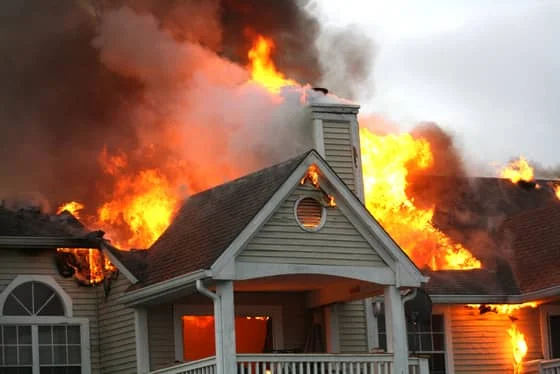If your home has suffered fire damage and you are thinking of selling a fire-damaged house, the repair process can also be a good time to consider changes you can make to reduce your carbon footprint and benefit the environment.
Here are 25 ways you could make your home and the surrounding area more environmentally friendly
- Think of all the small ways you could save water in the home, from turning the tap off while you brush your teeth to fixing that dripping faucet. Even small changes soon add up, saving water and reducing water bills.
- Consider replacing paved paths in the garden with low-
 lying vegetation. This will reduce water runoff and increase biodiversity.
lying vegetation. This will reduce water runoff and increase biodiversity.
- Consider using gray water − the “waste” water from the laundry and bathroom. As long as you use organic detergents, it’s perfectly safe for use as irrigation on your garden beds − just avoid spraying it directly on fruits and vegetables.
- Consider mulching your garden beds. Mulching with organic materials adds nutrients to the soil, preserves soil moisture (so less watering is needed) and prevents erosion by wind and rain.
- Think about installing solar power. The energy is free once you have the requisite equipment, and so will save on your energy bills over the long term. The initial cost can be off putting but increasingly you can arrange leasing or hire-purchase arrangements with solar power companies to offset or stagger the cost.
- Consider harvesting rainwater. Water is a very precious resource and a lot of it simply runs off into the municipal drainage system. Diverting rainwater from the roofs of your buildings to storage units helps reduce wastage, means you use less municipal water as irrigation (so saving money) and gives you access to water even in times of extreme shortage (such as heat waves), making you more self sufficient.
- Think about how often you upgrade your digital devices. Do you really need the latest version of a smartphone, or that slightly larger TV? Maintaining devices and replacing them only when unusable reduces waste and conserves the mineral resources needed for their production. It also saves you money.
- Consider starting a compost pile. By converting “waste” from the kitchen into compost for the garden beds you create a closed loop of energy, with the foods giving you energy when you eat them, and you giving the plants the foods came from energy by increasing the nutrient content of the soil.
- Think about how you use your washing machine. By only putting it on when you have a full load, and by reducing the temperature (even by just a few degrees), you save energy and water − and thus money on your household bills.
- Consider drying your clothes outside, as the tumble drier is one of the most energy-hungry of all household appliances. Sure, outside drying may take a little longer, but think of the energy and money you are saving.
- Consider replacing your conventional light bulbs with energy saving versions. They save you money, use fewer resources, and last longer.
- Think about all the ways on object could be reused on the site before you throw it out. Most things can be repurposed somehow. For instance, turn a bucket into a plant container, an old bath into a worm farm, or bottle tops into a deer deterrent.
- Think about getting rid of your lawn. It requires lots of water and maintenance, but does not give you a yield. Transform it into growing beds and reap the rewards of a useable harvest.
- Consider sheet mulching to transform areas of weeds to viable garden beds quickly. Layering cardboard, compost materials and newspaper over weeds denies them sunlight so they can’t photosynthesize. You can even plant crops into the sheet mulch to get a crop while clearing the unwanted plants.
- Think about ways to get some free manure. Local riding stables and farms will typically have lots of manure you can use. Composted, this manure will add loads of nutrients to your soil.
- Consider making keyhole garden beds. This style of bed maximizes the viable planting space, meaning you get more yield from your site, and increases the amount of edge − the interface between two environments − which is the most dynamic part of an ecosystem.
- Think about ways to cool your house. Install a door or plant a deciduous tree to shield your building from the summer sun, which moderates temperature and reduces air conditioning use, saving energy and money.
- Think about how you can attract birds to your site. Increasing biodiversity, instituting a body of water, and protecting them from predation by pet cats, will bring in birds, which will help keep insects under control, aid plant pollination and fill the garden with delightful birdsong.
- Consider taking showers rather than having baths. Showers use less water and less energy to heat the water − saving on water and heating costs.
- Consider using trees as windbreaks. This protects fragile plants from wind, attracts insects, birds, and wildlife, and moderates the site’s temperature, including the home.
-
Consider reducing your carbon footprint by using public transport instead of driving. Buy local, seasonal ingredients to minimize food miles.
- Think about your electrical appliances when they are not in use. Turning them off completely rather than putting them on standby will save energy and reduce electricity bills. For instance, a microwave not in use is still drawing in electricity just to power the clock − and you probably don’t need another clock in the kitchen!
- Consider catching the water you use to wash vegetables and do dishes. This moisture can be reused to irrigate the garden (just remember to use organic washing up liquid).
- Think about turning off all your appliances when you go on vacation. Plan to empty the fridge before departing and turn off the TV, entertainment devices, and kitchen equipment at the wall when you leave. It will save energy and reduce your bills.
- Think about sharing garden equipment with your neighbors. This approach saves everyone money by avoiding duplicate equipment purchases and fosters a collaborative, sharing community.
Looking to sell instead of repair a fire-damaged house?
Are you thinking of selling a fire-damaged house? Fill out the form below to see if your fire-damaged house qualifies for a free quote from We Buy Fire Damaged Houses. We pay all cash and buy fire-damaged houses in as-is condition.
Photo by Simon Wilkes on Unsplash

